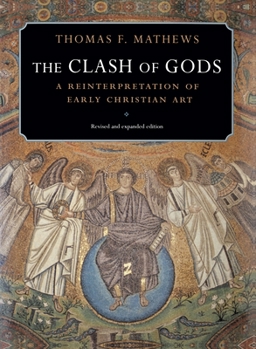The Clash of Gods: A Reinterpretation of Early Christian Art - Revised and Expanded Edition
Select Format
Select Condition 
Book Overview
Between the third and sixth centuries, the ancient gods, goddesses, and heroes who had populated the imagination of humankind for a millennium were replaced by a new imagery of Christ and his saints. Thomas Mathews explores the many different, often surprising, artistic images and religious interpretations of Christ during this period. He challenges the accepted theory of the "Emperor Mystique," which, interpreting Christ as king, derives the vocabulary...
Format:Paperback
Language:English
ISBN:0691009392
ISBN13:9780691009391
Release Date:April 1999
Publisher:Princeton University Press
Length:256 Pages
Weight:2.05 lbs.
Dimensions:0.6" x 7.4" x 9.9"
Customer Reviews
3 ratings
Refutes a long-dead theory of derivation from political emperor-art
Published by Thriftbooks.com User , 19 years ago
Mathews is primarily concerned to refute a particular early 20th-Century German and Eastern European ideological theory that the portrayal of Jesus in art was derived directly from the detailed portrayal of Roman emperors in art and that this artistic portrayal of Jesus as emperor legitimates imperial political structure, with an emperor, in the contemporary era (of 1920-1950). Mathews shows that the early artistic portrayal of Jesus presented him as a counter-Jupiter and all-ruler (pantokrator), not as a worldly emperor (kosmocrator). Jesus was also portrayed in early Christian art as androgynous and as the most powerful magician, and as a philosopher. The portrayal of Jesus in art consciously and deliberately presented him as anti-emperor. Sometimes Mathews confusingly asserts that the way Jesus was portrayed had absolutely nothing to do with the emperor, but in other chapters, originally published as separate articles, he asserts that Jesus was portrayed consciously and deliberately as a non-emperor. Mathews' extremist manner of expression and apparent self-contradiction reveals his succumbing to political fear of 20th-Century re-institution of emperors, resulting in a polemical mode of expression, which lacks precision. Mathews' overweening concern to refute an early 20th-Century political theory causes him to misstate or inconsistently describe his theory about how Jesus was portrayed and what the portrayals meant in the first few centuries. He ought to strike most of his invective against the very specific, quirky, and particular early 20th-century theory of artistic derivation that he confusingly labels with the ambiguous term "the emperor mystique", and instead explain consistently his positive position about how the Jesus figure did relate to or refute the figure of the emperor -- and, more to the point, how the Christ religion overall was artistically portrayed in relation to how the Roman imperial system of Pax Romana was artistically portrayed. Mathews ought to engage with the latest theories of Roman imperial theology/ideology, starting with the work of S.R.F. Price, and contribute directly to that effort, rather than devoting so much coverage to a particular 1930s-era view. That's the hardest aspect of reading this book: today's reader comes to it expecting commentary on Price and Horsley, but instead, finds a concern that seems to affirm most of Price and Horsley while being positioned as somehow "against the Emperor Mystique". This book is dissonant and confusing polemics until you figure out how to harmonize it with the sensible views of Price and Horsley. By the phrase 'the Emperor Mystique', Mathews doesn't have Price and Horsley's view in mind as one naturally expects these days, but rather, a particular quirky, specific theory of artistic-elements derivation of Jesus' portrayal, a theory that was in service of 20th-Century pro-emperor politics. No scholars are currently asserting that the artistic portrayal of
A necessary tool for the understanding of early christianity
Published by Thriftbooks.com User , 23 years ago
While Mathews has crafted an thorough polemic against what he calls the "Emperor Mystique" prevalent as a key hermenuetic of early christian art, he stimulated me to go beyond the declared intent of his thoughtful book. The author opens the door to the polyvalence of the symbolism of the art of the church, particularly from the third through the sixth centuries. Mathews presents the adaptation of Greco-Roman art forms and their translation into the competitive contexts of christian origins. While I was persuaded that Alfoldi and Grabar probably went too far in their attempt to link the art of the church with an exclusively imperial model, I still believe that many christians would have recognized elements of this model in viewing the paintings and mosaics of the church. Religious symbolism can function in multiple ways, both singly and in combinations depending on various religious, political, social, and economic agenda. This book is a useful complement to Averil Cameron's "Christianity and the Rhetoric of Empire."
Mathews explains clearly why Christanity won over Antiquity.
Published by Thriftbooks.com User , 25 years ago
This is a bold and clear reinterpretation of Early Christian Art. It moves the reader through a cany reseeing that respects and illuminates both the message and the people who received it. Mathews explains in an open and well documented way how Christian images fought and defeated the pagan gods. As an art historian trained with the rather confusing cannon of earlier scholarship I found it delightful reading.






